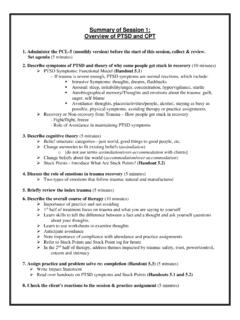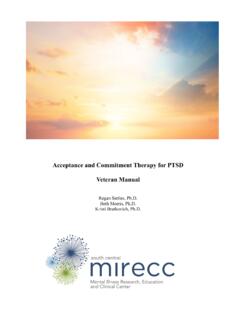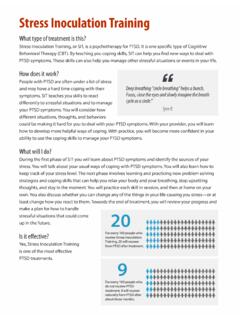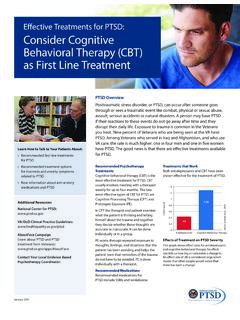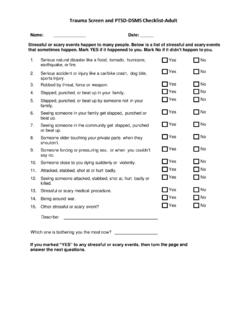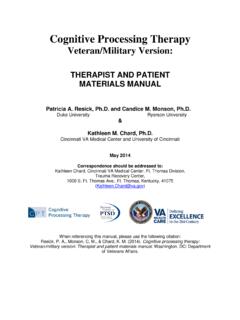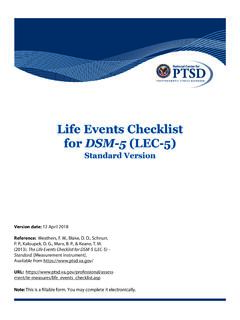Transcription of PTSD in DSM-5 - Division of Trauma Psychology
1 ptsd in DSM-5 Michelle J. Bovin, National Center for ptsd , Behavioral Sciences Division VA Boston Healthcare System Boston University School of Medicine Boston, MA Today s Talk ptsd symptoms in DSM-IV versus DSM-5 Initial research on DSM-5 ptsd Prevalence DSM-5 Factor Structure Dissociative Subtype How changes to the diagnosis have affected ptsd assessment instruments ptsd DSM-IV Criteria ptsd is an Anxiety Disorder with 6 Criteria: Criterion A: Stressor Criterion Criterion B: Reexperiencing Criterion Criterion C: Avoidance/Numbing Criterion Criterion D: Arousal Criterion Criterion E: Duration Criterion F: Clinically Significant Distress/Impairment ptsd DSM-5 Criteria ptsd is a Trauma - and Stressor-Related Disorder with 8 Criteria: Criterion A: Stressor Criterion Criterion B: Intrusion Criterion Criterion C.
2 Avoidance Criterion Criterion D: Negative Alterations in Cognition or Mood Criterion Criterion E: Arousal and Reactivity Criterion Criterion F: Duration Criterion G: Clinically Significant Distress/Impairment Criterion H: Not attributable to effects of substance/medical condition Criterion A: Stressor Criterion DSM-5 DSM-IV Criterion A1 ..1. Directly experiencing the traumatic event(s) 2. Witnessing, in person, the event(s) as it occurred to others 3. Learning that the traumatic event(s) occurred to a close family member or close friend. In cases of actual or threatened death of a family member or friend, the event(s) must have been violent or accidental 4. Experiencing repeated or extreme exposure to aversive details of the traumatic event(s) The person experienced, witnessed, or was confronted with an event or Exposure to actual or threatened death, serious injury, or sexual violence in one (or more) of the following.
3 That involved actual or threatened death or serious injury, or threat to the physical integrity of self or others Criterion A2 N/A Person s response involved intense fear, helplessness, or horror Criterion B: Intrusion Criterion DSM-5 DSM-IV: Reexperiencing Criterion B1 Recurrent, involuntary, and intrusive distressing memories of the traumatic event(s) Recurrent and intrusive distressing recollections of the event, including images, thoughts, or perceptions B2 Recurrent distressing dreams in which content and/or affect of the dream are related to traumatic event(s) Recurrent distressing dreams of the event B3 Dissociative reactions ( , flashbacks) in which the individual feels or acts as if the traumatic event(s) were recurring Acting or feeling as if the traumatic event were recurring B4 Intense or prolonged psychological distress at exposure to internal or external cues that symbolize or resemble an aspect of the traumatic event(s)
4 Intense psychological distress at exposure to internal or external cues that symbolize or resemble an aspect of the traumatic event B5 Marked physiological reactions to internal or external cues that symbolize or resemble an aspect of the traumatic event(s) Physiological reactivity to internal or external cues that symbolize or resemble an aspect of the traumatic event Criterion C: Avoidance Criterion DSM-5 DSM-IV: Avoidance/Numbing Criterion C1 Avoidance of or efforts to avoid distressing memories, thoughts, or feelings about or closely associated with the traumatic event(s) C1 Efforts to avoid thoughts, feelings, or conversations associated with the Trauma C2 Avoidance of or efforts to avoid external reminders that arouse distressing memories, thoughts, or feelings about or closely associated with the traumatic event(s) C2 Efforts to avoid activities, places, or people that arouse recollections of the Trauma D1 Inability to remember an important aspect of the traumatic event(s)
5 C3 Inability to recall an important aspect of the Trauma D5 Markedly diminished interest or participation in significant activities C4 Markedly diminished interest or participation in significant activities D6 Feelings of detachment or estrangement from others C5 Feeling of detachment or estrangement from others D7 Persistent inability to experience positive emotions C6 Restricted range of affect D2 Persistent and exaggerated negative beliefs ore expectations about oneself, others, or the world C7 Sense of foreshortened future Criterion D: Negative Alterations in Cognition and Mood DSM-5 DSM-IV: Avoidance/Numbing Criterion D1 Inability to remember an important aspect of the traumatic event(s) C3 Inability to recall an important aspect of the Trauma D2 Persistent and exaggerated negative beliefs or expectations about oneself, others, or the world C7 Sense of foreshortened future D3 Persistent, distorted cognitions about the cause or consequences of the traumatic event(s) that lead the individual to blame himself/herself or others N/A D4 Persistent negative emotional state N/A D5 Markedly diminished interest or participation in significant activities C4 Markedly diminished interest or participation in significant activities D6 Feelings of detachment or estrangement from others C5 Feeling of detachment or estrangement from others D7 Persistent inability to experience positive emotions C6 Restricted range of affect Criterion E.
6 Arousal and Reactivity Criterion DSM-5 DSM-IV: Arousal Criterion E1 Irritable behavior and angry outbursts typically expressed as verbal or physical aggression toward people or objects D2 Irritability or outbursts of anger E2 Reckless or self-destructive behavior N/A E3 Hypervigilance D4 Hypervigilance E4 Exaggerated startle response D5 Exaggerated startle response E5 Problems with concentration D3 Difficulty concentrating E6 Sleep disturbance D1 Difficulty falling or staying asleep Additional DSM-5 Criteria Criterion F: Duration of disturbance is more than 1 month Criterion E in DSM-IV Criterion G: The disturbance causes clinically significant distress or impairment in social, occupational, or other important areas of functioning Criterion F in DSM-IV Criterion H: The disturbance is not attributable to the physiological effects of a substance or another medical condition Specifiers DSM-5 DSM-IV With delayed expression With delayed onset N/A Acute versus Chronic With dissociative symptoms N/A Three Main Areas of Research Do the changes to the diagnosis affect ptsd prevalence?
7 What is the factor structure of the DSM-5 symptoms? How are individuals with the dissociative subtype different from other ptsd sufferers? DSM-5 Algorithm DSM-IV Algorithm Criterion A Stressor Criterion A Stressor 1 or more Criterion B items 1 or more Criterion B items 1 or more Criterion C items 3 or more Criterion C items 2 or more Criterion D items 2 or more Criterion D items 2 or more Criterion E items Criterion E (Duration of at least 1 month) Criterion F (Duration of at least 1 month) Criterion F (Distress/Impairment) Criterion G (Distress/Impairment) Criterion H (Not due to substance/medical condition) ptsd Prevalence 050100150200250 All SoldiersCombat ExposedSoldiersDSM-IV PTSDDSM-5 PTSDHoge, Riviere, Wilk, Herrell, & Weathers, 2014 ptsd Prevalence 050100150200 All SoldiersCombat ExposedSoldiersMet both DSM CriteriaMet only DSM-IV CriteriaMet only DSM-5 CriteriaHoge, Riviere, Wilk, Herrell, & Weathers, 2014 Understanding Discrepancy Common reasons to meet DSM-IV but not DSM-5 : Exclusion of non-accidental, non-violent deaths from Criterion A Requirement of at least 1 active avoidance symptom Common reasons to meet DSM-5 but not DSM-IV: Requirement of at least 3 Criterion C symptoms Requirement of at least 2 Criterion D symptoms DSM-5 Factor Structure Why is this important?
8 Implications for: Diagnostic algorithms Prevalence rates Individual diagnostic status Provides information about: Comorbidity Etiological models Allows investigation into association between symptom clusters and ptsd maintenance DSM-5 Factor Structure To date, eight CFA studies have tested various combinations of eight different models: 1 ptsd Factor DSM-5 Externalizing Behaviors Anhedonia 7-Factor Hybrid DSM-IV Dysphoria Dysphoric Arousal DSM-5 Symptom 1 ptsd factor DSM-5 Externalizing Behaviors Anhedonia Hybrid DSM-IV Dysphoria Dysphoric Arousal B1 Memories P R R R R R R R B2 Dreams P R R R R R R R B3 Flashbacks P R R R R R R R B4 Cued distress P R R R R R R R B5 Physical reactions P R R R R R R R C1 Avoiding internal reminders P A A A A A/N A A C2 Avoiding external reminders P A A A A A/N A A D1 Dissociative amnesia P NAMC NAMC NAMC NA A/N D NAMC D2 Negative beliefs P NAMC NAMC NAMC NA A/N D NAMC D3 Blame P NAMC NAMC NAMC NA A/N D NAMC D4 Negative feelings P NAMC NAMC NAMC NA A/N D NAMC D5 Loss of interest P NAMC NAMC AN AN A/N D NAMC D6 Detachment or estrangement P NAMC NAMC AN AN A/N D NAMC D7 Numbing P NAMC NAMC AN AN A/N D NAMC E1 Angry behavior P H
9 EB DA EB H D DA E2 Reckless behavior P H EB DA EB H D DA E3 Hypervigilance P H AA AA AA H H AA E4 Startle P H AA AA AA H H AA E5 Concentration P H DA DA DA H D DA E6 Sleep P H DA DA DA H D DA Results of CFA Studies Larger models tend to have the best fit 7 factor hybrid model is the best Fit for the DSM-5 four-factor model ranges from adequate to poor Implications of CFA Studies DSM-5 model may not be the best fit for the data Similar to research done with DSM-IV May inform next iteration of the ptsd diagnosis Additional research is still needed Dissociative Subtype Steuwe,Lanius, & Frewen, 2012 Dissociative Subtype Proportion: 6%-30% of Trauma exposed samples 15%-30% of ptsd samples Higher on: Conversion Borderline Features Facets of the Schizophrenia Spectrum More severe: ptsd Depression and Anxiety Symptoms Alcohol Use Problems Hostility Dissociative Subtype Dissociation in the Context of ptsd : Interferes with emotional processing May negatively impact treatment outcome Need additional research to determine how to best treat individuals with this subtype ptsd Assessment Instrument Modifications Changes to the ptsd diagnosis require changes to assessment instruments Changes have been made to National Center for ptsd instruments: Primary Care ptsd Screen (PC- ptsd ) Life Events Checklist (LEC) ptsd Checklist (PCL) Clinician Administered ptsd Scale (CAPS) Primary Care ptsd Screen Originally developed by Prins et al.
10 (2003) Trauma stem with four yes/no items Screen for ptsd in primary care Good psychometric properties Cutoff of 3 Primary Care ptsd Screen PC- ptsd -5 PC- ptsd Sometimes things happen to people that are unusually or especially frightening, horrible, or traumatic. For example, a serious accident or fire, physical or sexual assault or abuse, earthquake or flood, war, seeing someone be killed or seriously injured, or having a loved one die through homicide or suicide. Have you ever experienced this kind of event? If no, screen total = 0; if yes, continue with screening. In the past month, have In your life, have you ever had any experience that was so frightening, horrible, or upsetting that, in the past month, 1. Had nightmares about the event(s) or thought about the event(s) when you did not want to? Yes/No 1. Have you had nightmares or thought about it when you did not want to?
